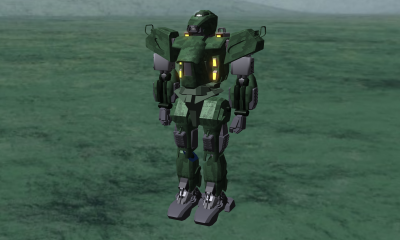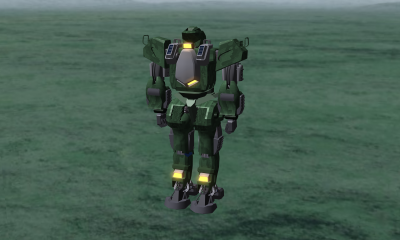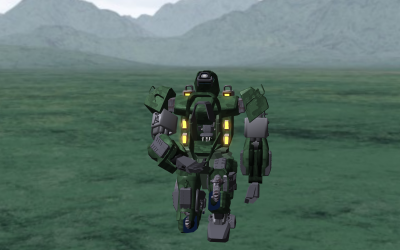Sidebar
Table of Contents
Spartan General Combat Mecha
The Spartan General Combat Mecha is Osman Heavy Industries' answer to a lighter combat-capable mecha than the Cyclops Heavy Combat Mecha.
About the Spartan
The Spartan is designed to hold its own in any combat situation, but it thrives in planetside situations, where its combination of armor, firepower, and mobility are most easily displayed. It is equipped with armor that is on par with more expensive mecha from other manufacturers, above average mobility for its price point, and enough firepower to let it leverage its other two advantages.
Key Features
The biggest feature of the Spartan is its reliability. Compared to the Cyclops Heavy Combat Mecha, which struggled in any situation other than ground combat, the Spartan is built to be able to hold its own against its more expensive competitors on the ground, in the air, and in the realm of space.
History
The Spartan was developed in YE 40 after Osman Heavy Industries had completed its move to the Yamatai. Once there, it began losing business to the vastly more well known Origin Industries and their line of general-purpose combat mecha. It was clear that the Oxen Multipurpose Mecha was too lightly armored and not combat capable enough to compete in such a market and that the Cyclops Heavy Combat Mecha was too unwieldy to fill the niche that mecha such as the OI-M1-1A Ashigaru and OI-M3-1A Gekido did, so the Spartan was developed as a low-cost alternative to them in a bid to retake the low-budget mecha market.
Rivals
The Spartan's two main rivals are the OI-M3-1A Gekido, and, to a lesser extent, the OI-M1-1A Ashigaru; while not as modular as the Gekido or as heavily armed in its stock form as the Ashigaru, the Spartan does boast a lower price point, improved ease of maintenance, and advantages in several key performance statistics.
It is also more maneuverable in all environments than either of its competitors due to the many thrusters located all over its body.
Appearance
The Spartan is a no-frills machine - it is utilitarian at its core, and its design reflects that; on it, exposed machinery such as pistons and wires can be seen at points such as the legs and arms for ease of maintenance. Armor plating can be placed over those exposed systems, however, the systems themselves are not actually at risk because of their high durability.
Aesthetically, the Spartan looks like a large broad shouldered armored humanoid with a small head that has thrusters dotting its torso and legs.
Statistical Information
General information about the Spartan General Combat Mecha, including the designer, manufacturer, some basic information, and a nomenclature tag.
- Organization: Osman Heavy Industries, Buyers
- Type: General Combat Mecha
- Class: OH-M3-1a
- Designer: Osman Heavy Industries
- Manufacturer: Osman Heavy Industries
- Production: Mass
- Price: 37,000 KS
- Crew: 1
- Maximum Capacity: 1
- Width: 4.5 meters1)
- Length (or depth): 2.8 meters
- Height: 8 meters
- Mass: 25 tons
Speeds
General information about the maximum speed attainable by the Spartan a variety of different environments. It should be noted that while the spartan is slower than some of its competitors, it is far more maneuverable
FTL
The Spartan is not capable of FTL travel without aftermarket equipment.
Damage Capacity
See Damage Rating (Version 3) for an explanation of the damage system.
- Shields: Tier 8, Medium Mecha
Interior
The cockpit of the Spartan is similar to that of the Oxen and Cyclops, with a full-body harness tucked away above the pilot.
There are viewscreens on the left and right of the cockpit's interior, a top forward monitor (that has a smaller rear viewscreen below it) - positioned above the main hatch, and the main monitor, which folds down after the main hatch closes and then folds out to cover the inside of the main hatch.
Pedals are in the same position where a footrest would be; lastly, a joystick and an instrument panel sit on each armrest
Getting In and Out
The spartan is designed for quick embarkment and disembarkment to allow pilots to quickly transition to an infantry role if nessecary. This necessitated a departure from the previous sliding cockpit block boarding system present on the Oxen Multipurpose Mecha and the Cyclops Heavy Combat Mecha. It is likely that this boarding method may not remain present in other mecha, except those which are also intended to allow for pilots to serve as infantry.
The Spartan is boarded by one of four methods:
- Climbing from a gantry onto the lower hatch and then into the cockpit.
- Riding up a mechanically-retracting line with a stirrup on the end of it, which allows the pilot to enter and exit the Spartan without the use of a gantry.
- Jumping up from the ground into the cockpit with assistance from the Spartan's AI.
- Being picked up by the Spartan's AI and having it place the pilot into the cockpit.
Weapons Systems
The Spartan has two different built-in weapons systems, both of which are focused on defense.
In addition, the Spartan supports hardpoint-based mounting of weapons and equipment on the shoulders, calves, forearms, and one on the rear of the waist. A variety of adapters are provided for mounting equipment from other manufacturers.
Optional Weapons
The standard main weapon of the Spartan is the OH-M3-W4000 50mm Rotary Assault Rifle.
Hardpoints
In addition to its other weapon systems, the Spartan boasts a number of hardpoints that can be used to mount additional OHI weaponry, including missile launchers and anti-power-armor coilcannons. These hardpoints are located on the outer thighs, the outer forearms, and the shoulders. While they are compatible only with OHI equipment by default, mounting hardware is available to make them compatible with other equipment.
Onboard Systems Descriptions
The following sections contain information about the various subsystems found onboard the Spartan General Combat Mecha.
Power Systems
The Spartan is powered by a single Class 1 Hyperspace Fuel Tap that feeds three miniature cold fusion reactors. The reason for three miniature cold fusion reactors is to allow for redundancy in the Spartan's power generation systems; as a last resort, the Hyperspace Fuel Tap can be used to power the entire craft.
These fusion reactors can be fueled for up to 12 hours of standard idle operation by internal fuel reserves before the fuel tap will have to be used to refill the fuel tanks. During combat, this time is cut to 8 hours.
Because the reactors are cold fusion-style reactors, there is a heating system in place to heat up waste plasma as it travels to the propulsion systems to temperatures that improve the efficiency in said systems.
The heating system is not present in the plasma routes that connect the reactors to the Spartan's pressurized plasma storage unit.
Shields
The Spartan uses conformal electromagnetic and gravitic shielding.
Propulsion
The Spartan's propulsion system is fueled by feeding waste plasma from the cold fusion reactor to the thrusters. This highly-efficient and highly-simple method of propulsion allows for greater acceleration and top speeds than most OHI mecha before it; if the thrusters are not being used, the waste plasma is cooled for safety and stored in a high-pressure containment tank where it can be held for reheating and usage later.
The reheating of stored plasma is done by passing it through the body of the mecha to cool other components. The difference in temperature is drastic enough to cool down all but the hottest components of the mech and heat the plasma up to the right temperature for use.
There are primary thrusters on the back thrust unit, at the top of the back, on the back of the legs, and finally in several locations on the front of the torso.
Maneuvering Thrusters
In addition to the main thrust units, the Spartan features numerous multi-nozzle style maneuvering thruster ports. Each of the maneuvering thrusters is composed of a small block with five ports; the first four ports are dedicated to up, down, left, and, right, while the fifth is dedicated to the outward face of the block. The maneuvering thrusters are fed from the same source of plasma as the primary thrusters, and their output can be tuned for fine adjustments, combat maneuvers, and high-gee evasive maneuvers.
The Spartan has maneuvering thrusters integrated into its armor in the following locations:
- Shoulders: Thrusters can be found on the front, back, and dorsal-facing surfaces of each shoulder.
- Forearms: Thrusters can be found on the left, right, and backward-facing surfaces of each forearm.
- Calves: Thrusters can be found on the front, back, and outward-facing surfaces of each calve.
Sensors
With a lack of available in-house sensor systems, OHI had to resort to commercially-available solutions - thus the Spartan was equipped with a Model 33 Artificial Optic Sensor inside its head, several back-up Multifunction Optical/Audio Sensory Suites (located on the torso, shoulders, and legs), and a Model 33 Sensor Array located within the rear of its head.
Computers
As was the case with sensors, OHI had to resort to commercially-available solutions due to the lack of available in-house computer systems - hence the Spartan comes with three Ge-T8-E3103 Computer Arrays (two for basic functionality and one for a targeting and flight assistance AI) and a Celestial OS Computer for target tracking; additionally, the third computer array is linked to a Model 33 Electronic Defense Array.
Internal Skeleton
The Spartan uses the same internal skeleton design as the Oxen Multipurpose Mecha, which has integrated high-powered servomotors and pneumatic systems and an inner skeleton that is wrapped in strands of high-powered artificial muscles interlaced with filaments of Liquid Ally.
This whole assemblage is covered in an outer skin of Liquid Ally that protects the innermost workings of the mecha, enacts basic and moderate repairs in the field, and perform basic maintenance activities autonomously - thereby decreasing maintenance times and costs.
Standard Equipment
The following is the equipment that comes standard with the Spartan General Combat Mecha.
There is also a small equipment rack for the storage of a pilot's primary and secondary weapon in the event that disembarkment is necessary.
OOC Notes
Alex Hart created this article on 2018/09/05 00:05; FrostJager approved it (using the checklist) on 2018/09/19 04:57.
| Products & Items Database | |
|---|---|
| Product Categories | mecha |
| Product Name | Spartan General Combat Mecha |
| Nomenclature | OH-M3-1a |
| Manufacturer | Osman Heavy Industries |
| Year Released | YE 40 |
| Price (KS) | 37 ,000.00 KS |
| DR v3 max | Tier 8 |
| Mass (kg) | 25,000 kg |
Page Tools
Terms of Service - Privacy Policy



